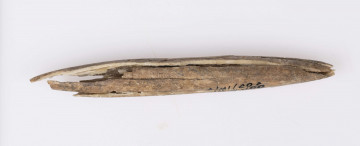
Edge
National Museum in Lublin
Part of the collection: Set of archaeological relics found in the Lublin Region
The presented monument was found in 1951, during the exploration of a Neolithic tomb in the village of Stok, in the Puławy poviat. During the field research of the site it turned out that there were remains of two people and numerous grave equipment, consisting of clay vessels and flint tools. Among them was the artefact described - a flat, four-sided axe, made of striped flint, carefully smoothed.
Archaeologists have been able to determine that the axe was created by a representative of the Globular Amphora culture, who lived around 5 thousand years ago. The name comes from the spherical vessels, characteristic of this culture.
The raw material from which the axe was made, flint, has been an excellent material for making various products since ancient times.
There are many varieties of flint, which differ both in appearance and properties. The striped variety from which the axe is made, which is of excellent quality, is one of the best for making tools. Its aesthetic qualities are attested to by the fact that even in modern times striped flint is very often used for making jewellery.
The flint used to make the tool most probably comes from the striped flint mine located near today's Krzemionki Opatowskie, where this mineral was mined for a very long time, both in the Neolithic and Bronze Ages.
And what did the process of making a flint axe look like?
At first, the general shape of the tool was formed from the lump of raw flint using a stone pestle. Then its surfaces were smoothed on the stone to obtain the desired shape. It could take up to thirty hours to get a well-smoothed axe.
Author / creator
Dimensions
cały obiekt: height: 16,7 cm
Object type
tool
Technique
grinding
Material
flint
Creation / finding place
Owner
The National Museum in Lublin
Identification number
Location / status